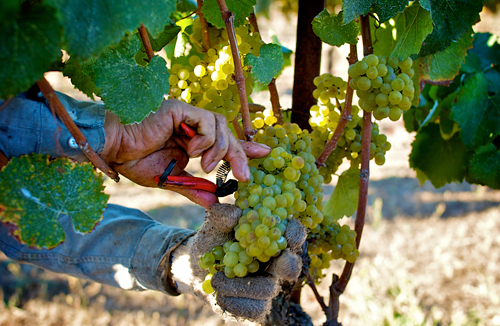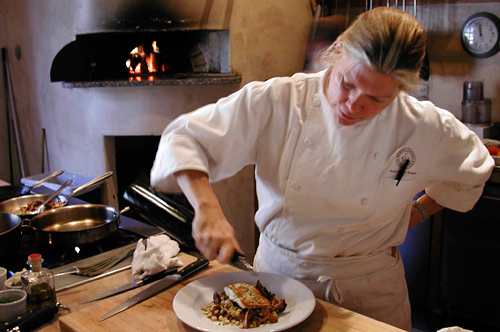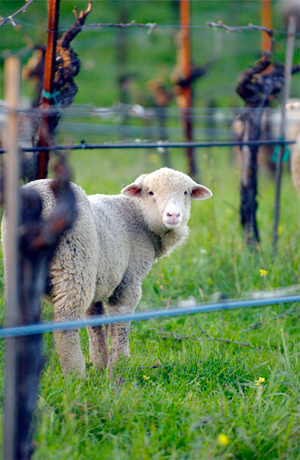There are many layers to biodynamic farming, but the basic premise involves taking organics one step further to create a holistic, "closed circle" ecosystem whereby all the land's fertility needs can be met on site. Animals provide manure, for example, manure goes into compost, compost goes into soil that then grows grass to feed the animals.
Hence the sheep, and the on-site composting program that transforms a good portion of the winery's spent grape pomace into a rich organic soil booster. That's just the tip of Steiner's philosophy, however. As a philosopher with a mystical Christian bent, Steiner's agricultural experiments in the face of industrial, post-WWI devastation blended time-honored Northern European folk traditions (planting by the phases of the moon, assigning the calendar "root days" and "fruit days" based on planetary movements) with his own personal beliefs in astral energy planes and more.
Walking a path between the grapes, Miller quotes a friend and fellow biodynamic farmer as saying, "You can farm on your knees or on your feet." Meaning that you can follow Steiner's dictates as a spiritual practice or as a practical how-to; either way, the results speak for themselves. Do you have to believe that a cow's horn symbolizes a kind of bridge between the earth and the sun, and that adding manure aged for months inside a buried cow's horn to your compost will energize your plants?
Perhaps, perhaps not. But there's no denying that building an intimacy with every aspect of a piece of land, from the way the wind moves over it to what weeds grow there, builds an awareness that translates into deep knowledge, informed by care and maybe even love.

Grapes on the vine. Photo by Robert Sinskey
Hanging on the cusp of harvest, the grapes are vividly indigo, green-gold, rose amber or plum black. The land itself feels rich with life, from the bees darting in and out of the flowering weeds below to the birds pecking their portion of the harvest from the ends of the rows.
The Zinfandel grapes are almost comically huge, ripe-to-bursting clusters hanging blue-black in the hot early-autumn sunshine. The Pinot Noir berries are smaller and shyer, almost dainty, the Cabernet Sauvignon vines looking straight out of a Claude Chabrol film. Muscat, clear gold, is unmistakable, the juice sugar sweet with a hint of musk. I remember reading a description of a summer morning in Venice as having "light like pink grapes" and these clusters of rosy Pinot Gris turn the simile suddenly clear.
All well and good. But how do the wines taste? After visiting numerous blocks of Sinskey's grapes, growing in the Stag's Leap and Carneros appellations, Miller takes me back to the elegant public tasting room on the Silverado Trail. Here, too, the idea of a self-fufilling ecosystem continues.
Wine is, after all, meant to drunk with food. So there is a small but lovely open kitchen adjoining the tasting room, where house chef Alex Bolduc whips up small complementary palate-teasers to accompany the $20 tasting flights, using produce harvested in the surrounding kitchen garden. The winery also runs special culinary tours ($50 per person, by appointment), in which guests get a guided tour through both the caves and the gardens, followed by a wine, cheese, and charcuterie tasting. It helps, of course, that Sinskey's culinary director is his wife, Maria Helm Sinskey, well-known cookbook author and formerly the highly acclaimed chef of San Francisco's PlumpJack restaurant.

The open kitchen in the tasting room. Photo by Robert Sinskey
The day I visited, Bolduc was simmering a batch of pear butter on the stove, made with green pears harvested from the Sinskeys' backyard. Once finished, it would jarred and sold in the tasting room or used on the menu of one of the winery's popular wine-club dinners, held every few months. While wine-club members get first dibs at reservations, interested diners can always call to see if any seats are available. Upcoming dinners include a Fall Equinox Dinner on Sept. 19th, and a Harvest Dinner on Oct. 24th. The price for six courses accompanied by wine is $175 per person.
In the tasting room, I nibbled a bit of aged gouda dotted with homemade plum jam, alongside a buttery mini-quiche filled with tatsoi, roasted onions, and cream, a moist gougere and some delectable slivers of pizza hot from the wood-burning oven. (Pizza Thursdays, a new development, are not to be missed).
And then there were the wines. I've long been a fan of Sinskey's Vin Gris as a elegant summer cooler. But the pours were more autumnal that day, starting with the Vandal Vineyard Pinot Noir. This parcel gets temperatures some 10 to 15 degrees warmer, bringing out the juicy richness and depth of the fruit, with hints of leather and smoke. "It's a more masculine wine," suggests sales manager Meg Barkley, and I have to agree: it seems to call out for leg of lamb, deep leather armchairs, dark wood paneling and a roaring fire.
A Pinot Noir from the Three Amigos parcel, some 5 to 7 miles away, is quite different, leaner and lighter, with less smoke and more cherry. "This one's my duck wine," says Barkely.
Sinskey only recently started doing single-designation Pinots, and the choice of vineyards changes from year to year, depending on the quality of the fruit.
It's one more part of the winemaking philosophy espoused by owner Rob and his longtime vintner, Jeff Virdig, who has been working with Sinskey since 1991: bring the fruit to its peak, then get out of the way and let the grapes express their own truth.


